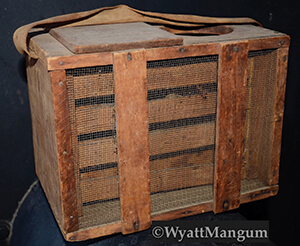
In the mid 1800s, the apicultural industry began to flourish in America. By the early 1900s numerous small bee supply businesses were scattered across the country. While exceptions did occur, most of these bee businesses seemed to live fairly brief lives, serving local beekeepers, before time consigned them to the forgotten past. Evidence of these bee supply companies comes from their surviving supply catalogs, although mostly they are rare.
For this article, I picked two of these obscure bee supply companies, one from the East, the other from the Midwest. From their supply catalogs, we can get a glimpse of beekeeping from about a hundred years ago.
Robert G. Coombs of Guilford, Vermont, sold Italian bees and a line of beekeeping supplies. Figure 1 shows the cover of his catalog for 1915, the 55th annual circular (begun in 1860). As with other states in the Northeast, Vermont has a rich historical tradition of beekeeping (Mares and Conrad, 2020). Here we see one company coming to Vermont from Massachusetts, bringing a long history itself, beginning in 1860, just a year before the start of the Civil War (see Figures 2 and 3).
Coombs not only sold queen bees but also supplied package bees, or “bees by the pound,” as they were once called. The bees were sold starting on June 15th. In his catalog, Coombs reported that removing a pound of bees in May and before the first half of June damaged the colony too much. From a more large-scale industry view, queen and package bee production development, which began in the North, shifted to the South, because of the early seasonal start. Coombs in Vermont waiting until June 15th explicitly shows his disadvantage. (Over a century later with Africanized Honey Bee genes in the South, the emphasis on bee stocks better matched to local environments, and a greater understanding of spring bee management, queen rearing and bee production in the North, have experienced a revival of sorts.)
Coombs sold two- and three-pound packages of bees, the amounts familiar to beekeepers today. I once bought 50 two-pound packages and boosted them by giving each new colony a frame of capped brood. Nevertheless, in my time, two-pound packages do not frequent the advertisements like they once did. Further back in Coombs’ time, he offered even smaller package sizes: a one-pound package and a half-pound package.
What does a half pound of bees even look like? Well, begin with what we know, three pounds of bees in a package at room temperature. Imagine a third of that, essentially a pound of bees. Then one half of that would leave a half pound of bees, admittedly not many bees. Coombs had a 1915 spring price for a half-pound package of $1.50; the summer price dropped to $1.00. (The spring price was from June 15 to July 15, and the summer price was from July 15 to October.)
Coombs reported “… an unusual large call the past few seasons for bees by the pound and half pound packages. …” He assured potential customers he would build a light-weight wooden package to keep the express charges low.
From the 1915 catalog, Figure 4 shows his style of shipping package used by some beekeepers at the time. The package is small for shipping a pound or half pound of bees. The slats inside, appearing woven, were probably to give bees more surfaces for clustering, and to help them endure rough travel (considering the wagon ride from the freight station to the farm over dirt or muddy roads in the spring). Figure 5 shows a rare surviving package before standardization eliminated this style.
Before shipping bees on combs became illegal because of possibly spreading American foulbrood, bee producers shipped nucs by railroad express. Although they were queenless, Coombs offered “nucs” in one, two, three, or five frames. From the catalog, it looks like the beekeeper picked the queen stock, paying extra, otherwise the brood frames of bees could boost existing colonies. However, Coombs’ main claim was for building them into full-size colonies, even from one frame of brood. Figure 6 shows the style of shipping box that Coombs used, a design used by others. Made of thin wood, these nuc shippers were built lightweight to reduce express shipping costs. In a time when cooking and heating were commonly done by burning wood, these nuc shippers would have been easily smashed and burned (or saved as kindling wood to start the fire). Their firewood value and the ephemeral practice of nuc shipping have made these very specialized shipping boxes difficult to find (see Figure 7). When looking through catalogs of obscure beekeeping supply companies from over 100 years ago, something surprising can be seen with any turn of the page.
Near the end of the Coombs catalog is a picture of a sugar syrup feeder mounted to the entrance of a hive, incorporating a special square glass jar. The device is called the Thale’s Regulative Vacuum Bee Feeder (see Figure 8). The design was an attempt to have a dripless feeder that would not waste syrup and cause robbing. I have never seen a complete feeder, only a couple of jars (see Figure 9).
Page and Lyon Manufacturing company is another bee supply company that is not well known. This company was located in the Midwest, in New London, Wisconsin (see Figure 10). As typical of other bee supply companies, they made several styles of frame hives, supers, and comb honey sections.
What caught my eye was their selection of bee smokers. Page and Lyon sold a couple of smokers from ….


